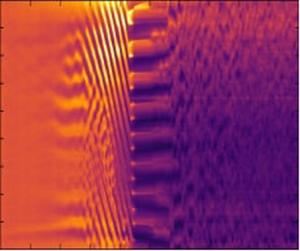Article contents
Shear-thinning mediation of elasto-inertial Taylor–Couette flow
Published online by Cambridge University Press: 24 March 2021
Abstract

We study the shear-thinning mediation of elasto-inertial transitions in Taylor–Couette flow of viscoelastic polymer solutions. Two types of high molecular weight polymers are used at various concentrations and in water–glycerol solvents of various viscosities. This allows us to access a wide range of elastic numbers and effective shear-thinning indices. Conservative ramp-up (slow acceleration of the inner cylinder and subsequent increase in Reynolds number) and steady-state (constant rotation speed) experiments are performed, in which the flow is monitored continuously using flow visualisation. Depending on the shear-thinning and elastic properties of the working fluid, very different behaviours are observed. In almost constant-viscosity fluids (Boger fluids), or shear-thinning fluids with significant elasticity, the flow transitions from purely azimuthal Couette flow (CF) to a highly chaotic flow state referred to as elasto-inertial turbulence (EIT) via Taylor vortex flow (TVF) and elasto-inertial rotating spiral waves (RSW). When the degree of shear-thinning is increased and elasticity reduced, elastic waves or EIT may fade to a wavy Taylor vortex flow (WTVF) with increasing inertia. Significant shear-thinning leads to a delay in the onset of EIT. Remarkably, in some highly shear-thinning cases, even with a significant elasticity, elastic flow features (EIT, RSW) are completely suppressed, and the flow exhibits a ‘Newtonian-like’ transition sequence (CF–TVF–WTVF). Shear-thinning acts to modify, delay, or even completely suppress elasto-inertial behaviours (RSW, EIT), that would otherwise have existed in the absence of shear-thinning. It is, thus, possible to induce various hydrodynamic regimes by tuning the relative degrees of shear-thinning, elasticity and inertia.
- Type
- JFM Papers
- Information
- Copyright
- © The Author(s), 2021. Published by Cambridge University Press
References
REFERENCES
- 16
- Cited by



